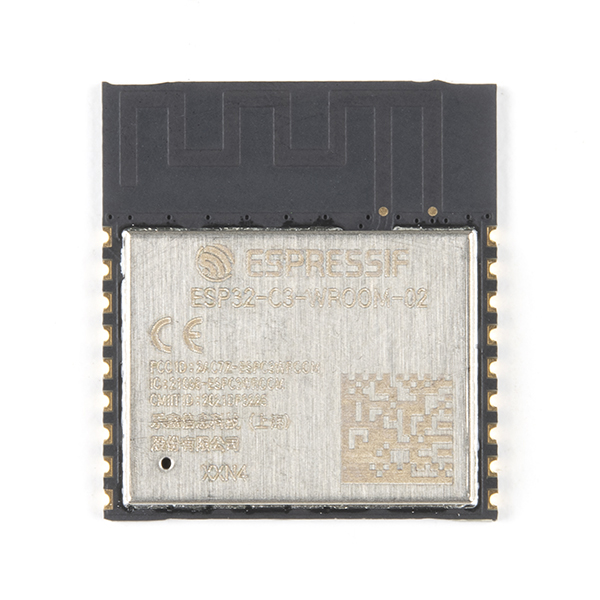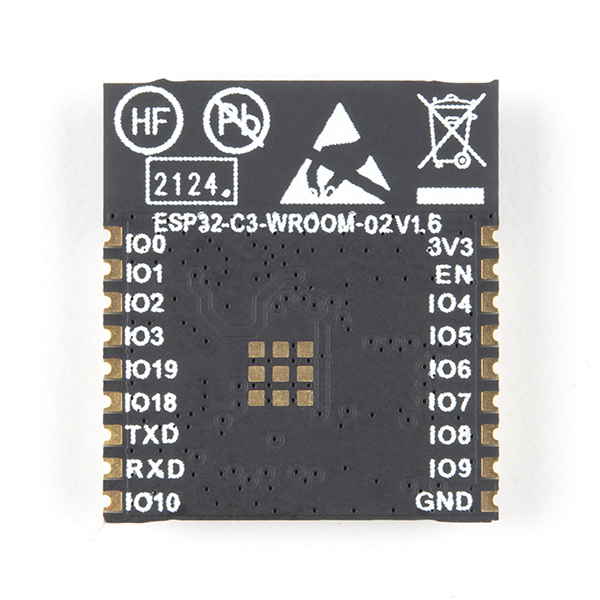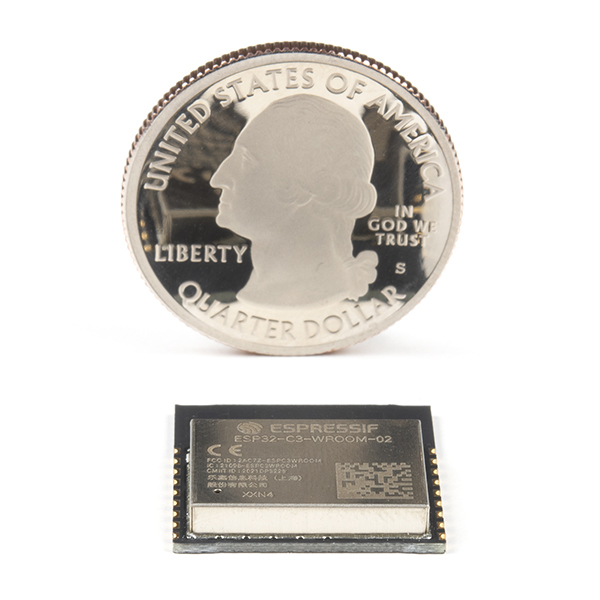ESP32-C3 WROOM Module - 4MB (PCB Antenna)
The Espressif ESP32-C3 is the next version of the popular ESP32 Bluetooth® and WiFi enabled module. This module features a single core, RISC-V-based processor with WiFi and Bluetooth LE 5.0 radios built into the SoC. The module features a PCB antenna and castellated plated pins for surface-mount soldering. This variation has 4 MB of on-board SPI flash and is the 85 °C temperature tolerant version.
The 32-bit core RISC-V microcontroller features a maximum clock speed of 160 MHz. With 22 configurable GPIOs, 400 KB of internal RAM and low-power-mode support, it can facilitate many different use-cases involving connected devices. The high-temperature support makes it ideal for industrial and lighting use-cases as well. The module is supported through Espressif’s open-source ESP-IDF making it easy to develop around.
WiFi and Bluetooth LE 5.0 with long-range (LR) support help building devices with great coverage and improved usability. ESP32-C3 continues to support Bluetooth LE SIG Mesh and Espressif WiFi Mesh. Furthermore, the solid RF performance of ESP32-C3 is sustained at a higher operating temperature.
Security is now a main feature of the ESP32 line. The ESP32-C3 ensures that the availability of features, such as the RSA-3072-based secure boot and the AES-128-XTS-based flash encryption, can be used to build connected devices securely. The innovative digital signature peripheral and the HMAC peripheral provide a secure device identity for applications. Hardware acceleration support for cryptographic algorithms ensures good performance for the secure communication both in a local network and with the Cloud.
MCU
- ESP32-C3 embedded, 32-bit RISC-V single-coreprocessor, up to 160 MHz
- 384 KB ROM
- 400 KB SRAM (16 KB for cache)
- 8 KB SRAM in RTC
WiFi
- IEEE 802.11 b/g/n-compliant
- Center frequency range of operating channel:2412~2484 MHz
- Supports 20 MHz, 40 MHz bandwidth in 2.4 GHzband
- 1T1R mode with data rate up to 150 Mbps
- Wi-Fi Multimedia (WMM)
- TX/RX A-MPDU, TX/RX A-MSDU
- Immediate Block ACK
- Fragmentation and defragmentation
- Transmit opportunity (TXOP)
- Automatic Beacon monitoring (hardware TSF)
- 4 × virtual Wi-Fi interfaces
- Simultaneous support for Infrastructure BSS inStation mode, SoftAP mode, Station + SoftAPmode, and promiscuous modeNote that when ESP32-C3 family scans in Stationmode, the SoftAP channel will change along withthe Station channel.
- Antenna diversity
- 802.11mc FTM
Bluetooth
- Bluetooth LE: Bluetooth 5, Bluetooth mesh
- Speed: 125 Kbps, 500 Kbps, 1 Mbps, 2 Mbps
- Advertising extensions
- Multiple advertisement sets
- Channel selection algorithm #2
Hardware
- Interfaces:
- GPIO
- SPI
- UART
- I2C
- I2S
- remotecontrol peripheral
- LED PWM controller
- general DMA controller
- TWAI® controller (compatible withISO 11898-1)
- temperature sensor
- SAR ADC
- 40 MHz crystal oscillator
- 4 MB SPI flash
- Operating voltage/Power supply: 3.0~3.6 VDC
- Operating ambient temperature: –40~85 °C (This is the 85 °C version module)
- Dimensions: (18.0 × 20.0 × 3.2) mm
- Interfaces:
ESP32-C3 WROOM Module - 4MB (PCB Antenna) Product Help and Resources
Core Skill: Soldering
This skill defines how difficult the soldering is on a particular product. It might be a couple simple solder joints, or require special reflow tools.
Skill Level: Competent - You will encounter surface mount components and basic SMD soldering techniques are required.
See all skill levels
Core Skill: Programming
If a board needs code or communicates somehow, you're going to need to know how to program or interface with it. The programming skill is all about communication and code.
Skill Level: Competent - The toolchain for programming is a bit more complex and will examples may not be explicitly provided for you. You will be required to have a fundamental knowledge of programming and be required to provide your own code. You may need to modify existing libraries or code to work with your specific hardware. Sensor and hardware interfaces will be SPI or I2C.
See all skill levels
Core Skill: Electrical Prototyping
If it requires power, you need to know how much, what all the pins do, and how to hook it up. You may need to reference datasheets, schematics, and know the ins and outs of electronics.
Skill Level: Competent - You will be required to reference a datasheet or schematic to know how to use a component. Your knowledge of a datasheet will only require basic features like power requirements, pinouts, or communications type. Also, you may need a power supply that?s greater than 12V or more than 1A worth of current.
See all skill levels
Comments
Looking for answers to technical questions?
We welcome your comments and suggestions below. However, if you are looking for solutions to technical questions please see our Technical Assistance page.
Customer Reviews
No reviews yet.




